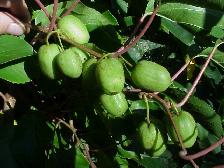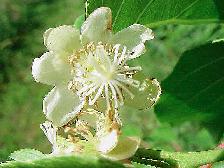A
Tale of Hardy Kiwifruit
INTRODUCTION
The delicious fuzzy green kiwifruit found in your local market
is NOT a tropical fruit as many consumers believe. They are a crop of
mild temperate climates where the growing season is over 200 days long and winter
temperatures drop below 10º Fahrenheit only briefly. So unless you live
in such a favored area, you still can't grow kiwifruit at home, right?
Wrong! There are over 40 other species in the Asian genus Actinidia
which are distributed from the tropics of Vietnam north throughout China, India,
Japan and Korea and into Siberia. Not all of them produce palatable fruit, but
a few from the more northern parts of the range do, and some are even sweeter
and more flavorful than the commercial kiwifruit. Some will tolerate winter
temperatures that drop as low as -40º F and their fruit are hairless and easy
to eat. They have few pests and diseases and are relatively easy to grow,
but they do have some negative points.
 First
they are all vines. That may be OK for you, but it does mean more work
than a tree requires. You must provide STRONG supports, because a healthy
producing kiwi vine will be vigorous, even rampant, and can produce crops in
excess of 100 pounds. They will need extensive annual pruning and training,
if only to cut out dead wood and direct the growth of the remaining wood.
First
they are all vines. That may be OK for you, but it does mean more work
than a tree requires. You must provide STRONG supports, because a healthy
producing kiwi vine will be vigorous, even rampant, and can produce crops in
excess of 100 pounds. They will need extensive annual pruning and training,
if only to cut out dead wood and direct the growth of the remaining wood.
Second, they need
well drained but evenly moist soil. One of the few diseases that bother them is Phytopthora,
a root rot which will quickly kill even a well established plant if the roots are
subjected to soggy, oxygen starved soil conditions for even short periods.
Third,
they often begin growing with the first warm days of spring, well before the
last frost, and the new growth will be killed by even a light frost as if the
plant was tropical. Usually a healthy plant will send out new shoots,
but any fruit for that year will be lost. If you want fruit, and your
area is subject to late spring cold snaps, find a protected area to grow it
in.
 Fourth,
To get fruit you must have both a male, which produces no fruit, and a female.
There is at least one variety that is advertised to produce fruit without the
need for a male, but its fruit is considered by many to be of inferior quality
and the plant itself is not much hardier than the commercial kiwifruit (Despite
what the catalogs say).
Fourth,
To get fruit you must have both a male, which produces no fruit, and a female.
There is at least one variety that is advertised to produce fruit without the
need for a male, but its fruit is considered by many to be of inferior quality
and the plant itself is not much hardier than the commercial kiwifruit (Despite
what the catalogs say).
If you are ready
to face all these challenges, growing hardy kiwifruit will be worth it all when
you taste that first, sweet, juicy, emerald berry.
Last edited on 4
April 2000
©2000 by Dan Sorensen
 First
they are all vines. That may be OK for you, but it does mean more work
than a tree requires. You must provide STRONG supports, because a healthy
producing kiwi vine will be vigorous, even rampant, and can produce crops in
excess of 100 pounds. They will need extensive annual pruning and training,
if only to cut out dead wood and direct the growth of the remaining wood.
First
they are all vines. That may be OK for you, but it does mean more work
than a tree requires. You must provide STRONG supports, because a healthy
producing kiwi vine will be vigorous, even rampant, and can produce crops in
excess of 100 pounds. They will need extensive annual pruning and training,
if only to cut out dead wood and direct the growth of the remaining wood.
